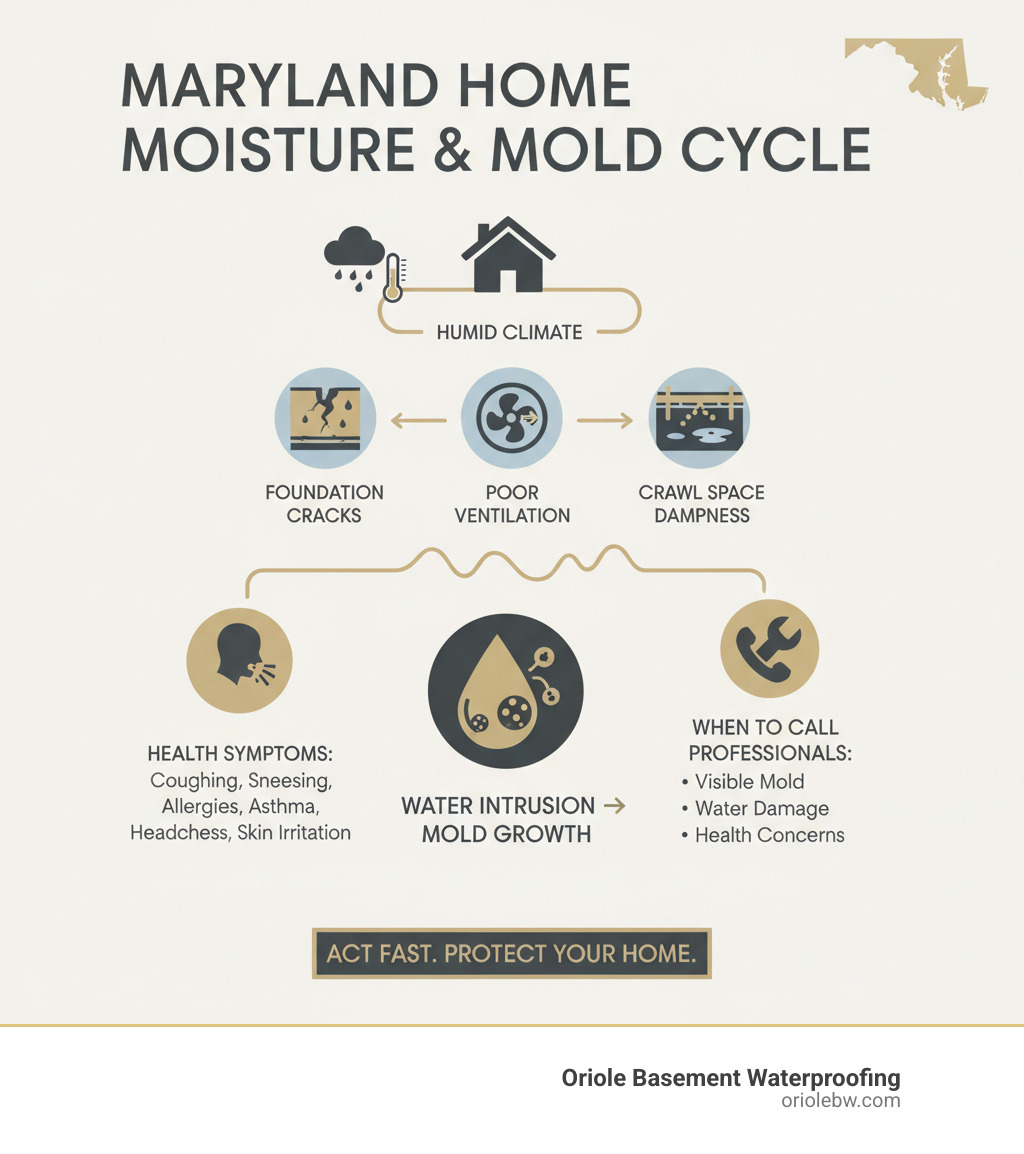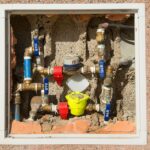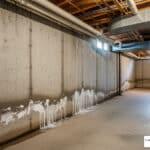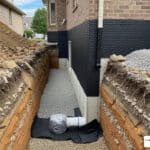Introduction: That Musty Smell in Your Maryland Basement Isn’t Normal
Ever walk into your Maryland basement and catch a whiff of something… off? That musty odor isn’t just unpleasant; it’s often a tell-tale sign of mold. Beyond the smell, you might spot visible discoloration or notice peeling paint. These aren’t just cosmetic issues. They’re symptoms of a deeper problem: water intrusion. In Maryland’s humid climate, moisture is mold’s best friend.
That persistent musty odor wafting up from your basement isn’t just unpleasant. It’s your home telling you something is wrong. In Maryland’s humid climate, that smell often signals mold growth, and ignoring it can lead to health issues and costly structural damage.
Mold thrives in our local weather. High humidity, seasonal flooding, and the construction of many older homes in Baltimore City, Baltimore County, and Harford County create perfect conditions for fungal growth. What starts as a small water leak or damp crawl space can quickly become a full-blown mold problem affecting your family’s health and your home’s value.
Here’s what many Maryland homeowners don’t realize: mold is almost always a symptom of a bigger moisture problem. You can clean visible mold all you want, but unless you fix the underlying water intrusion from foundation cracks, poor drainage, or crawl space humidity, the mold will keep coming back.
Fixing the root cause of moisture is the only way to solve the issue for good, and it often prevents much larger expenses down the road.

Your Guide to Professional Mold Remediation in Maryland
Finding mold in your home feels like finding an unwelcome guest who’s been living rent-free in your basement. It’s unsettling and frustrating, especially when you think about what it might mean for your family’s health.
Here’s what we’ve learned after more than 70 years of helping Maryland families: mold remediation in Maryland isn’t just about scrubbing away what you see. It’s about understanding why it showed up and making sure it doesn’t come back.
Spotting the Signs and Understanding the Risks
Your nose often knows first. That musty, earthy smell from your basement or crawl space is a red flag, not something to get used to.
Beyond the odor, look for other signs. Visible discoloration can appear as dark spots on basement walls or fuzzy patches on floor joists. Don’t assume it has to be black to be a problem; mold comes in green, white, and even orange. Peeling paint and warped wood also signal hidden moisture, and where there’s persistent water, mold is never far behind.
Sometimes, your body sounds the alarm. Persistent coughs, allergy-like symptoms that flare up at home, or general stuffiness can point to mold spores in your air. These effects are often felt most by children, the elderly, and anyone with respiratory issues. If your family feels better when away from the house, it’s time to investigate what’s happening in your basement or crawl space.
A wet basement is more than just a mold factory; it signals deeper issues. Our guide on Causes and What to Do If You Have a Wet Basement explains how these problems start.
Why Water Damage is Mold’s Best Friend
Here in Maryland, our weather rolls out the red carpet for mold. From steamy summers to heavy spring rains, the conditions are perfect for growth.
Mold spores are always present, waiting for moisture to activate. They can colonize a damp area in as little as 72 hours.
Foundation cracks are a common entry point, allowing groundwater to seep into your basement. Leaky basement walls are another, as pressure from saturated soil forces moisture through concrete. High humidity during our muggy summers creates condensation on cool basement surfaces, providing a steady water source.
Crawl space moisture is a particularly sneaky problem. Since many homeowners rarely enter this space, moisture can build up for years, allowing damp, moldy air to rise throughout the home. Poor drainage, like overflowing gutters or downspouts dumping water near the foundation, only makes these issues worse.
We’ve built our reputation on solving these underlying moisture problems with comprehensive Basement Waterproofing and Foundation Repair solutions. You can clean mold all day, but if you don’t fix the water problem, it’s a temporary fix at best.
The Right Way to Handle Mold Remediation in Maryland
When you find mold, the first instinct is often to grab bleach and start scrubbing. While understandable, effective mold remediation requires a more strategic approach.
The most critical step is source identification. We can’t stress this enough: mold is a symptom of a moisture problem. Until you eliminate the water source, any cleanup is just a temporary band-aid. Our process starts with a thorough inspection to find exactly where moisture is entering your home.
For significant mold problems, professionals use containment to seal off affected areas and prevent spores from spreading. They use HEPA air scrubbers to capture airborne particles. The safe removal process then begins, which may involve removing porous materials like drywall or cleaning non-porous surfaces. Finally, structural drying with industrial dehumidifiers ensures the area is completely dry before any restoration.
At Oriole Basement Waterproofing, we focus on the moisture control piece of the puzzle. If we find active water intrusion, we address that problem first. For large-scale mold cleanup that requires specialized techniques, we refer these jobs to our trusted partners who specialize in mold removal. This approach makes sense because removing mold while water is still getting in is like trying to empty a tub with the faucet on. Fix the water problem first.
There’s a crucial step many homeowners skip. Learn more here: Why You Shouldn’t Remove Mold Before Doing This One Thing.
Choosing a Reputable Waterproofing and Repair Expert
Finding the right team to tackle your moisture issues shouldn’t be a guessing game. You need professionals who understand Maryland’s unique challenges.
Experience matters. Every older home in Baltimore City, Baltimore County, and Harford County has its own quirks. Our 70+ years of local experience means we’ve seen just about every moisture scenario these homes can present.
Look for transparent pricing and solid warranties. A reputable company provides detailed estimates and stands behind their work. We offer a lifetime transferable guarantee on our encapsulation and foundation repairs because we are confident in our methods.
Engineering-backed solutions are crucial when foundation issues cause moisture problems. We partner with structural engineers on major foundation repairs, ensuring our solutions provide long-term structural stability. The best companies take a holistic approach, assessing everything from exterior drainage to indoor humidity. This comprehensive view means you won’t be calling back in a few years with the same problem.
Customer testimonials and a strong local reputation show whether a company’s solutions actually last. You can also check with organizations like the Basement Health Association to find companies committed to industry best practices.
The Best Prevention: How to Stop Mold Before It Starts
The best way to deal with mold is to prevent it from ever starting. Proactive moisture control is cheaper and far less stressful than a major cleanup.
Crawl space encapsulation is one of the most powerful preventive measures for Maryland homeowners. By sealing your crawl space from ground moisture with a heavy-duty vapor barrier, we eliminate the humidity that mold needs to grow. An encapsulated crawl space stays dry, clean, and improves air quality throughout your entire home. Learn more about this game-changing service: Crawl Space Encapsulation.
Dehumidifier integration takes moisture control to the next level. We install high-capacity, commercial-grade dehumidifiers as part of our systems to maintain humidity levels where mold cannot thrive.
Sump pump systems protect basements from water accumulation. An interior drainage system collects water and pumps it safely away from your foundation. We also offer battery backup systems for protection during power outages.
Simple exterior maintenance, like keeping gutters clean and ensuring the ground slopes away from your foundation, is also key. Finally, foundation repair and sealing addresses the structural entry points for water. Whether it’s using carbon fiber reinforcement for bowing walls or applying comprehensive waterproofing membranes, fixing these core problems is the ultimate prevention.
By taking a proactive approach to moisture control, you protect your home’s structure, improve air quality, and safeguard your family’s health.
Create a Healthy, Dry Foundation for Good
Finding mold in your Maryland home can feel overwhelming, but it’s valuable information. That musty smell is telling you that moisture has found its way where it doesn’t belong.
After seven decades in Baltimore City, Baltimore County, and Harford County basements, we’ve learned that the best mold remediation starts with stopping water at its source. If you don’t fix the underlying moisture problem, the mold will always come back.
Our holistic approach makes the difference. We dig deeper to understand why your basement or crawl space is damp. It could be foundation cracks, poor drainage, or a humid crawl space pulling moisture up through your house.
Our engineering-backed solutions tackle these problems permanently. When we use carbon fiber straps to fix a bowing wall or replace a damaged sill plate, we are preventing future headaches. Our crawl space encapsulation creates a moisture barrier that transforms damp spaces into clean, dry areas, improving your home’s air quality.
Every solution we install comes with our lifetime transferable guarantee. This protects your family’s health and your property value for decades. We partner with structural engineers on major foundation repairs to ensure our solutions maintain your home’s structural integrity. We create long-term solutions that give you genuine peace of mind.
Don’t let a musty odor or moisture damage compromise your home. The sooner you address the root cause, the better.







